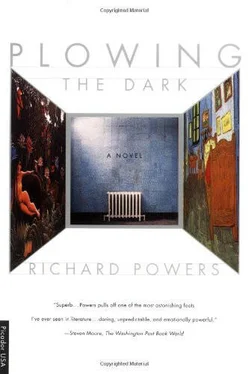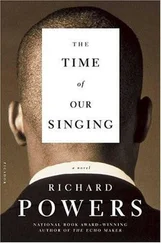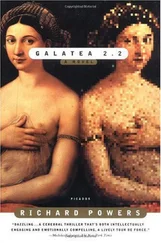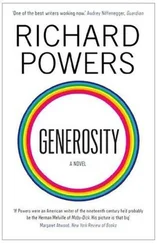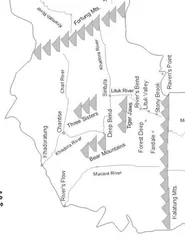Pinching from Stance and Kaladjian, O'Reilly assigned the wand's thumbwheel to a zoom function. A little scrolling and the Earth swelled to a medicine ball or imploded into an atom. With the rub of a thumb, Afghanistan, as it had lately in the world imagination, ballooned from an invisible speck to a billboard that filled the field of view.
When the globe grew large enough, O'Reilly simply stepped inside. The Cavern knew where his head was at all times, and rehung its coordinates accordingly. The crust of countries that the projectors served up looked even better from the underside than from the out. Inside, from the vantage of the earth's core, O'Reilly could inspect the whole theater at one glance, with no hidden hemisphere on the far side of a projection. The unbroken surface spread out above him in all directions, like the constellations of the night sky.
He set the wand's buttons to throw various layers over his planetarium display. The slices of tonal register tracked the range of a variable as it wrestled its way through the proving grounds. Armed with canned data, O'Reilly took the globe out for a test spin. Per capita GDP, in single-year time frames. As a function of energy consumption. As a function of consumer spending. All the classical formulae, for which he had only clinical patience, ran as ten-second, color-strobing short subjects before Our Feature Attraction.
To this clean, coherent display, Ronan fused his ten-dimensional recursive cellular automata. All the furious systems, the flex and tension of abductors and carpals clasped together in an invisible hand to rock a cradle now eminently observable. On the surface, sunsets and dawns illuminated the familiar jigsaw of the world's nations. Underneath, a seething snake's nest of cooperation and competition rippled through the global markets, deciding them.
O'Reilly plagiarized Stance and Kaladjian for one more essential component. Their backward-running breezes inspired him to flip the vector heads on time's arrow. The simplest possible test for any futures game consisted in finding out whether it could predict the past.
He created three dozen interdependent variables, each chained recursively to the others, a multivoiced conversation about per capita petrochemical consumption. He initialized his starting point to mimic the data for 1989. His seed numbers came straight out of definitive industry tables. He assigned the range of output values to the visible spectrum. North America read out as a hot red, Europe more magenta. China languished down in the aquamarines, but clearly coming on strong.
The touch of a button set the film in motion upon inexorable sprockets. He let the simulation run for a few years. From the still point of the turning world, O'Reilly watched the colors craze like maples in a Vermont October. The foliage exploded with all the glorious look and feel of fact. The passage of three real months seemed to vindicate his three-month trial runs. But did small errors of assumption — miscues in the continuous conversation — propagate through the system, breeding phantom spikes and dives, nonsensical artifacts, spurious squalls from out of the blank boundaries of forecast?
Ronan had no way to say with any certainty. Short-term success implied nothing at all about the long run. And just because a simulation worked once or twice or even a thousand times under divergent circumstances, that said nothing about the ever-irreducible next time. The future had this tenacious way of turning a pebble in the streambed into a continent-sculpting meander.
No amount of success proved that the gears in O'Reilly's box bore any relation to the great gears that he hoped to model. The world at large had no gears. Nothing in it knew how the futures market would work out. Regarding crude oil sales, the world at large knew only last year's numbers.
So be it: O'Reilly had last year's figures as well. Past would be his entree into posterity. While not rigidly deterministic, his iterative democratic negotiations were still reversible. If modeling could spill the milk, modeling could just as easily unspill it. O'Reilly reset his simulated world to his own moment. He took up his viewing post at the planetary core and ran the history of petroleum consumption in reverse. He rewound in slow motion, eyeballing each region's patina of color as it eased back down the rainbow. After a year, he froze the frame and toggled to the numeric display. The values fell within acceptable thresholds of error.
He threaded back another three years. The transcript coughed up a bubble here or there, but nothing that seriously undermined data's likeness. The readout's colors hove remarkably tightly to the curve of actual shortage and glut. Session after session, Ronan laid into the rewind button. He lifted a decade off the world's life, then a dozen years, reversing the effects of global aging with his fast-acting wrinkle cream.
Then he arrived back at the middle 1970s, the great oil crisis. There he and history abruptly parted company. His numbers hit that geopolitical slick patch, and the loss of traction sent them skidding off into an alternate universe. From there on back, all resemblance between estimate and fact broke down.
For the span of a month, Ronan himself hit the skids. He reverted to a rate of alcohol consumption that matched the worst of his Belfast days. Work had come to nothing. How could math — even the innovative math of multiagent dialogs — ever hope to factor in such a wild card? It seemed that, in order for simulation to cope with the shocks of radical sheik, it would have to contain as many interdependent variables as the Arabian Peninsula had grains of sand.
Rajasundaran found him at The Office, defeated. What's your problem today, Irishman?
The bloody Arabs.
And what have they done this time? It's never-ending with those chaps, isn't it? You'd think that your Crusaders would have long ago taught them to mind their manners.
They've messed up the world of rational multivariable extrapolation, is what they've done.
Oh. I thought that was your Adam and Eve.
Desperate, O'Reilly took Rajan and Spiegel into the Cavern. To show them the extent of the leak and to enlist their help in bailing.
Rajan thrust his head into the spinning globe. Oh my beautiful word. This is amazing. Pardon me, Ronan baba, but I'm never coming out of here.
Spiegel whistled. Nice stuff, Ronan. Freese is going to pop with pleasure.
Yes, you apes. But it doesn't mean anything. It's a piece of pretty gibberish.
Hey, Spiegel said. That's what the nineties will be looking for.
My code couldn't reverse-calculate the last oil crisis. How in the hell is it going to predict the next one?
May I ask the possibly obvious question? Rajan said. Why, in fact, do you want to know these things?
The future? Why do I want to know the future? You must be kidding me. That's the grand prize, friend. The end of the tunnel. The great escape.
These people. These white people. They're truly dangerous.
I don't get it, Spiegel said. What's with all this backward prediction stuff?
It's just a calibration tool. A convenient way of seeing how reliable the simulation engine is. Since I can't very well test my numbers by peeking forward..
No. I mean, if you want to see if you can predict 1973, why don't you just start in 1968 and—
Oh bloody Christ. That's brilliant. Utterly brilliant. That never would have occurred to me in a million years.
Rajan cackled like a banshee. Yours is a wilderness mind, Ulster-man. A true wilderness mind.
O'Reilly returned to them a week later, even more dejected. No luck. 1 queued up a simulation, setting all the starting variables to three years before the embargo. And the program blew right through the decade without so much as a hiccup. Oh, it managed a tiny spike, I suppose. But according to my little digital men, oil never rose more than a few dollars a barrel.
Читать дальше
